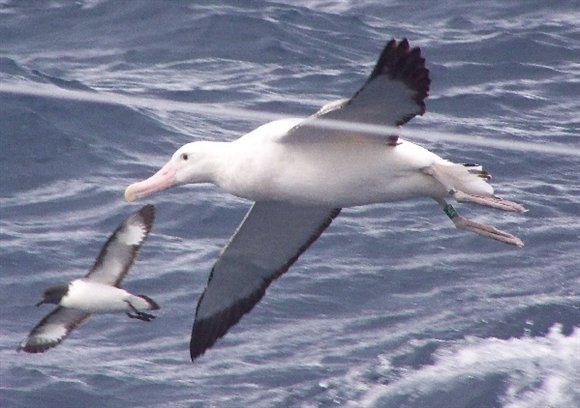Andy Reynolds (Rothamsted Research, Harpenden, U.K) writing in the journal Animal Behaviour has looked at purported Lévy flights in Wandering Albatrosses Diomedea exulans. A Lévy flight "is a random walk which the step-lengths have a probability distribution that is heavy-tailed."

Wandering Albatross foraging at sea. Photograph by Sebastian Jimenez
The paper's abstract follows:
" Viswanathan's et al.'s (1996, Nature, 381, 413-415) analysis of the flight patterns of the wandering albatross, Diomedea exulans, led to an explosion of interest in biological Lévy flights and to an accumulation of evidence that a wide variety of animals have movement patterns that can be approximated by Lévy flights. Subsequently, it became apparent that the analysis of Viswanathan et al. (1996) was seriously flawed. Attributing Lévy flights to wandering albatrosses now appeared to be an error that nevertheless served as the basis for new insights into animal behaviour. Here I revisit the issue in light of recent evidence that fishy-scented odours facilitate prey location in these birds. Using a simple mathematical argument I show that the touchdown locations (positions of the located odour sources) of odour-mediated anemotactic (upwind) flight patterns form a Lévy ‘dust'. Lévy flight patterns are therefore predicted to be an emergent property of olfactory searching in turbulent environments. In accordance with the reanalysis of the empirical data, flight lengths are predicted to be gamma distributed when prey lying in nearby crosswind locations can occasionally be detected by purely visual means. These predictions are supported by the results of numerical simulations. The finding invites a further re-examination of the flight patterns of the wandering albatross and provides new insights into the movement patterns of many animals that can locate odour sources in turbulent environments."
Reference:
Reynolds, A.M. 2012. Olfactory search behaviour in the wandering albatross is predicted to give rise to Lévy flight movement patterns. Animal Behaviour doi.org/10.1016/j.anbehav.2012.02.014
John Cooper, ACAP Information Officer, 22 March 2012

 Français
Français  English
English  Español
Español